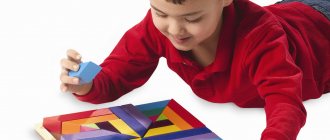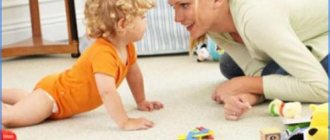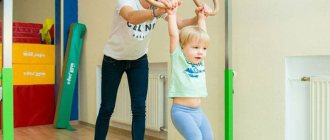What are fine motor skills in children?
“The White-sided Magpie,” “The Horned Goat is Coming,” “Ladushki-Ladushki”—every mother knows these nursery rhymes. And any baby loves it when his mother runs her index finger over his palm, bends and straightens her fingers, and reads a rhyme. It seems that there is nothing special in this game. But in fact, this is one of the simplest ways to develop fine motor skills in children, known to many generations of parents.
Fine motor skills are fine movements of the hands and fingers. How deftly a child in early childhood builds towers from cubes, dresses a doll and wields a spoon while eating depends precisely on the development of fine motor skills of the hands. A preschooler will show his level of hand skills by tying his shoelaces before a walk, gluing an applique for his mother for March 8th, and assembling a construction set from small parts. The teacher will quickly figure out an untrained first-grader from the first copybooks: if a child preferred football to mosaic, then his handwriting, as a rule, is worse.
Therefore, it is better to start preparing a child’s hand in time for complex and delicate operations, and a child for adult life.
Fine motor skills in children are the basis for the development of mental processes such as attention, memory, perception, thinking and speech. Developing it is important for children of any age. Almost everything a small child does (except for outdoor games) is operations with objects, through which he not only learns their properties and purpose, but also gets acquainted with the world as a whole. Therefore, it is important to offer him a wide variety of fine motor activities.
Let's see what kind of activities these are and what games and toys for hand motor skills will be useful to us.
By the way, “Agusha” fruit puree in sippy packaging is specially designed so that the baby can practice fine motor skills by unscrewing and screwing the cap and squeezing the puree in the gently rustling packaging in his hands.
It is necessary to develop fine motor skills in a child from early childhood. Fortunately, this is not difficult at all. Let's list the simplest and most accessible means (in order of the child's maturation).
A SET OF EXERCISES FOR THE DEVELOPMENT OF FINE MOTOR SKILLS IN CHILDREN OF PRIMARY SCHOOL AGE
Periods of child development in preschool age
The famous Italian teacher Maria Montessori identified three periods of children's development:
• development of children's speech (from 0 to 6 years). At this time, two important events occur. From 1 year to 2.5 years, a child’s vocabulary quickly expands. At 4-4.5 years old, he masters writing (but only if fine motor skills are developed);
• perception of small objects (from 1.5 to 5.5 years). At this age, the child loves to play with buttons, beads, sticks, etc. With the help of such objects, you can develop the motor skills of the child’s hands. Just be sure to make sure your baby doesn’t put them in his mouth;
• formation of simple self-service skills (from 1 year to 4 years). At this age, the child is taught to dress, eat and perform hygiene procedures independently.
Motor skills are of 3 types:
- large;
- small;
- certain organs.
Gross motor skills include rolling over, walking, bending, crawling, jumping, running, and the like. Gross motor development typically occurs from top to bottom. First, the child learns to control eye movements, then arms and legs.
Gross motor skills are a kind of foundation on which fine motor movements are superimposed with age. They are more subtle and complex.
Fine motor skills are very important for a child's development. The nerve endings located on the tips of the baby's fingers help transmit many signals to the brain center, so the influence of fine motor skills on the development of the child as a whole is obvious.
Fine motor skills are the performance of precise small movements using the fingers and hands. Typically, a child who has a high level of fine motor development is intellectually ready for school. He reasons logically quite well, he has developed attention and memory, and coherent speech.
But, unfortunately, 70-80% of first-graders have an unsatisfactory level of fine motor skills. This leads to underdeveloped hands; it is difficult for a young student to withstand prolonged hand tension while writing, and prevents the child from developing good handwriting. The student cannot draw sufficiently straight and clear lines; it is difficult to write numbers and letters; it is not easy for the child to cut out shapes from paper and along the contour, etc.
The development of fine motor skills is closely related to the development of speech. The child cannot clearly express his thoughts or explain his point of view. All of these factors show how important fine motor skills are for students.
The development of motor skills in schoolchildren is the most important task of teachers. Gross motor skills will help the student be more dexterous and relieve various problems associated with growth. At school age, scoliosis (curvature of the spine) and stooping are quite common. Special exercises will help strengthen bone tissue and help your child grow up healthy. To do this, you need to attend physical education classes. While younger schoolchildren attend them with pleasure, in middle, and even more so in high school, some students try to avoid classes. It is important for the teacher to understand the reason. Perhaps the child is not interested and should think about how to raise the prestige of physical education classes. Sports competitions and clubs contribute to the development of gross motor skills. At school age, it is advisable, in addition to physical education, to engage in additional sports training. This could be swimming, basketball, football, etc. Dancing also perfectly develops general motor skills.
To develop fine motor skills in schoolchildren more effectively, we can recommend the following:
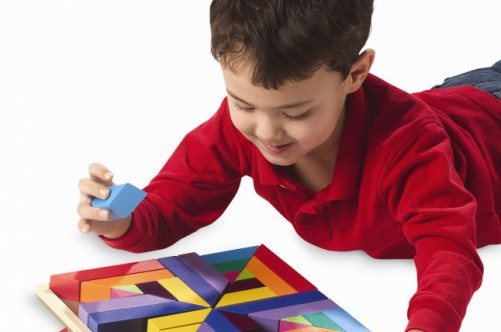
Construction;
Drawing;
Exercises with mosaics;
Cutting out various shapes with scissors;
Translating pictures by tracing an outline through carbon paper;
For boys - working with tools;
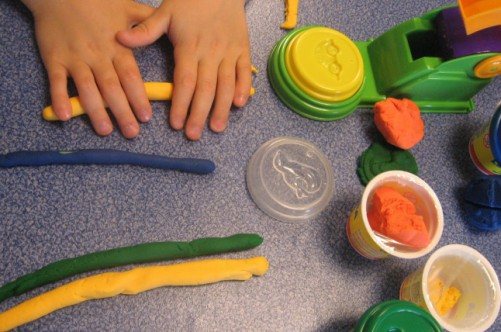
For girls - embroidery, knitting;
Sorting out peas and cereals for cooking during home economics lessons;
Playing the piano, accordion, guitar, etc.;
Modeling from plasticine, clay;
Turning pages of books;
A child can develop fine motor skills not only at school by attending clubs, but also at home. There are very, very many types of such activities. Parents should involve their child in activities that are interesting and accessible to him. For example, my mother and grandmother started baking pies. The child will be happy to help replace the dough and carefully sculpt the pies.
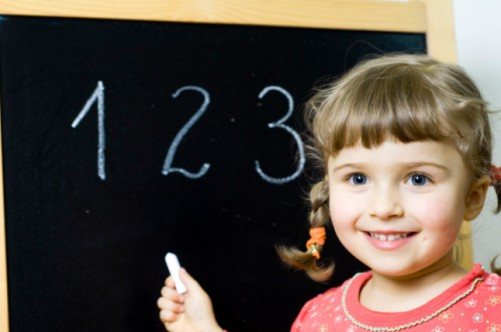
In the summer, you can work together with your children to weed the garden, collect garden and forest berries, and then sort them. Older children will be able to peel and cut boiled vegetables (not with a sharp knife). Thanks to all these interesting, systematically performed exercises, the child’s hands will gain precision, strength and coordination of movements.
Now we can dwell in a little more detail on some of the means of successful development of motor skills:
Various educational toys help develop fingers. In addition to improving motor skills, they will awaken in the child a desire to experiment, think logically in order to perform constructive actions. Memory and imagination are also trained. After all, a schoolchild must remember the actions that adults showed him.
"Creation". Modeling, drawing, designing, applique - practicing these types of activities will help not only improve fine motor skills, but also develop attention, perception, imagination, and develop a sense of color.
"Games with balls." Several types of balls can be used. They can be different in size, color, material, texture.
A variety of sets of small balls will allow you to use those that will help you complete the teacher’s tasks, based on the age and physical characteristics of the child.
As you can see, the development of motor skills helps improve the child’s speech, memory, attention, and imagination. During non-school time, parents themselves can find many exciting activities for their child to develop his motor skills.
Recommendations for parents
1. Exercises to develop fine motor skills are carried out in a complex, starting from the first months of a child’s life.
2. In the set of exercises, try to include tasks for squeezing, relaxing and stretching the baby’s hands.
3. Start or end your sessions with a hand massage session.
4. Carry out work on developing fine motor skills regularly, in accordance with the age and taking into account the level of physical development of the baby.
5. At first, the adult performs all movements with the baby’s hands, and as the child masters it, he begins to do them independently.
6. Carefully ensure that the child performs the exercises correctly. If your child finds it difficult to complete any task, immediately help him: fix the desired position of his fingers, etc.
7. Alternate between new and old games and exercises. After your child has mastered simple motor skills, move on to mastering more complex ones.
8. Perform certain movements simultaneously with listening (and then with the child pronouncing) the poem.
9. Encourage your child’s creative activity, let him come up with some exercises himself.
10. Conduct classes emotionally, actively, praise your child for his successes, but do not forget to monitor his mood and physical condition.
Exercises to develop fine motor skills for children over 2 years old
1. "Fisherman"
Pour water into a bowl and throw in several small objects: pieces of cork, twigs, large beads, etc. Invite your baby, using a small sieve tied to a stick, to catch all these objects in turn and put them on a plate on the tray on the right from the bowl. The baby should hold the “fishing rod” with one hand.
2. "Path"
Make a path 3-5 cm wide on the table, bounded on both sides by strips of paper. Invite your child to sprinkle it with semolina or millet. You need to pick up the cereal with three fingers and try not to spill it over the edges of the path.
3. “Magic Spoon”
Place two cups on the tray: on the left is a cup with cereal, and on the right is empty. Moving your child's hand, show him how to take the cereal with a spoon. Carefully bring the spoon to the empty cup and tip it over it. Task: pour all the cereal from the left cup to the right one.
4. “Sweet tea”
Your baby can already add sugar to his tea on his own. Now teach him to stir sugar in a mug.
From 8 months: inserts
- Cups, jars, bowls, nesting dolls, children's toy dishes. Any household items (safe for the child), varying in size, which the baby will endlessly “test for compatibility”: assemble, disassemble, insert, lay out, knock them against each other. “I’m developing fine motor skills, mom, be patient!” Can be offered to a sitting child from 6 months.
- Boxes, jars with lids, bags - the baby learns to open and close.
- Sorters (boxes with slots of different configurations and elements of the appropriate size and shape). Wooden, plastic, round, square, in the shape of dogs or boats - whatever you like. They usually become a favorite pastime no earlier than 8–9 months. You can do without a purchased toy. A clean shoe box made of thick cardboard, windows cut out with scissors and objects of appropriate shape (large buttons and beads, cubes, etc.) - the baby will be busy with them for a long time. You'll even have time to wash your hair or drink your morning coffee (we can't promise everything at once!).
- Twisting and unwinding. Caps, lids, toy screws - everything that can be screwed on or turned in one direction or the other. It is not necessary to buy special sets - just offer your baby a plastic bottle with a lid or a plastic thermos.
- Wooden cubes, pyramids, abacus, knockers with hammers, construction sets, simple musical toys, insert frames. They satisfy the baby's cognitive interest, develop spatial orientation and - what is most important for us now - improve small hand movements, develop coordination and dexterity.
Methods of performing manual massage
There are several types of massage that can help in the baby's learning process. Each age has its own technique and its own characteristics. You can do standard massage movements or transform the exercises into games for development. With preschool children, make appliqués, with small ones, knead your palm with a ball, learn to hold a pencil or other small objects that will fit in a child’s hand. You can also pour sand from one place to another.
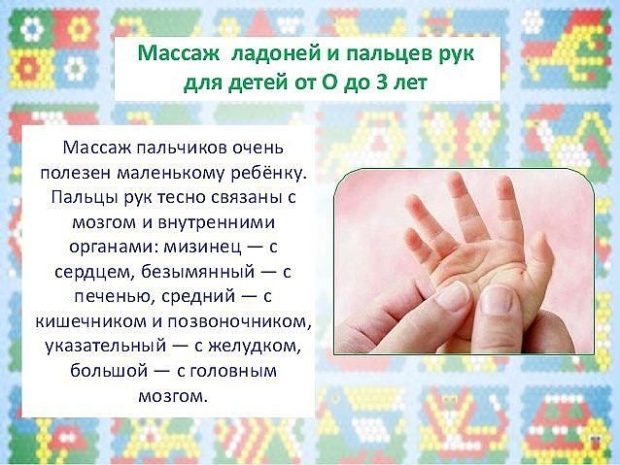
For newborn babies
For a newly born baby, stroking, pinching, kneading and vibration-oscillatory movements are often used. The massage procedure is carried out as follows: place the child’s palm on your own and gently stroke first all the fingers at once, and then separately. You should stretch your baby's hands carefully so as not to cause discomfort. Apply pressure on the child's palm and fingers in a circular motion, then slowly clench and unclench them into a fist. In a similar way, you need to influence each of the child’s hands. For a baby, the massage should last no more than three minutes.
After 3 months, you can teach the child to take toys from the hands of the parent. If the baby is afraid or does not show interest, you can stroke his hands on both sides. You can also teach him to reach his legs with his hands. To make the exercise more interesting, put bright socks with funny images on your child’s feet.
Read also…. Acupuncture points of the foot and massage
For children from 9 months
At this age, you can show your child how to roll a ball or a car and teach greeting gestures. You can also help him learn how to close and open boxes or jars, show him how to feed dolls, build a pyramid from cubes, and then take it apart.
For children over one year old
When the age of children changes, the massage technique also becomes different. The procedure begins with kneading the entire arm at once. First, it should be stroked from the elbow to the fingertips, then using pressing movements, stretch each finger along the entire length towards the hand, moving to the wrist. Next, use light pinching to work the lateral areas of the hands and the hills at the base of the fingers. After this, bend and straighten your fingers alternately and shake your hand a little. For the best effect, you need to recite poems or tongue twisters so that the child can enjoy the process and quickly remember the movements and learn to speak.
Massage game
Games with paper. For children in preschool age and infancy, play exercises using lumps of paper are suitable. The child must crumple the sheets into paper balls, from which they can then make some kind of toy by gluing the lumps together.
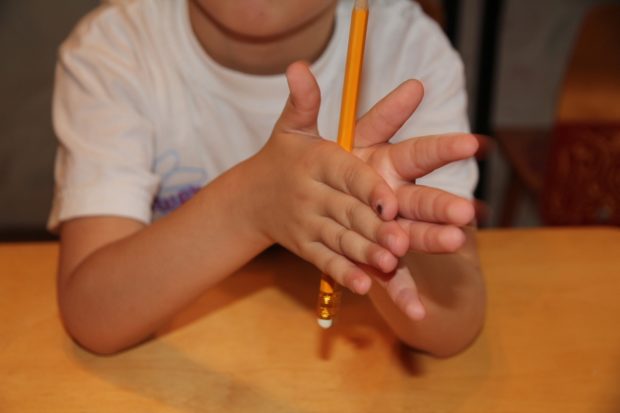
Games with small details. To develop fine motor skills and learn colors, you can invite your child to place cubes in bowls. Place red cubes in the first bowl, yellow cubes in the second, etc. You can also get creative and make appliques from different types of cereals.
Snow game. In this version of massage, balls of different sizes and textures, tightly folded into a bag or small bag, act as massagers. The child should lower his hand inside and move it a little. At the end of the game, the baby scatters the balls, creating a semblance of snowfall.
From 1 year: natural materials
- Sand games: buckets, molds, shovel, Easter cakes. A lesson for several seasons. At first, your mother (grandmother, nanny) will make the molds. We recommend starting with large molds: with their help you can make even shapes without crumbling edges (any “imperfection” can make kids angry; they strive for ideals in everything).
- Plasticine, plastic clay, salt dough. We roll sausages, make koloboks, strings and glue them into a hoop. Such activities perfectly strengthen the muscles of the hand, make the fingers more dexterous and mobile, and expand the child’s ideas about his capabilities. At a later age, your child will proudly bring figurines of hedgehogs, bunnies and dogs from kindergarten classes, which will begin to settle on your bookshelves. You cannot treat them with disrespect - these are the first products of a child’s labor, he values them very much!
- Cones, pebbles, sand, pebbles, walnuts (in shell) and chestnuts. The latter are collected during a walk in the fall, stuffed into pockets, brought home and washed. Now it’s useful to knead them in your palms, two at a time, and rotate one around the other.
- Games with any bulk materials. The child puts his hands into a vessel with some homogeneous filler (sand, various grains, pellets, any small objects). Stirs the contents for a few minutes. Then he is offered a vessel with a filler of a different texture. After several trials, the child, with his eyes closed, puts his hand into the offered vessel and tries to guess its contents without feeling its individual elements with his fingers. At the same time we develop speech. Do this only under the supervision of an adult: small objects are not recommended for children under 3 years of age to play with.
Invite your child to play “Cinderella” - sort beans, peas, large beads, dry pasta of different colors into different containers.
From 1 year: first self-care skills
- Spoon, toothbrush, comb. By the age of one year, they definitely end up in the baby’s hand. They not only allow you to practice self-care skills, but also develop coordination and fine motor skills. By kindergarten we learn how to fasten and unfasten Velcro and buttons on shoes or clothes, and lace up shoes.
- Laces, beads. There are many beautiful lacings in stores, from simple ones (you can try them as early as a year) to complex ones (not earlier than 3 years). You can get by with a piece of cardboard with holes made in it, the main thing is to find a cord with a thick and durable tip or a wooden needle. Beads also don’t have to be bought in the form of ready-made sets - you can cut rings from felt and string them onto ribbons. Such simple and affordable material as dry tube pasta (penne, rigatoni, cannelloni - usually indicated on the package) is also used. It’s good if such activities are daily: they perfectly develop sensorimotor coordination, eye, attention, perseverance, and prepare the hand for writing. They are successfully used as a favorite work material for children in kindergartens working according to the Maria Montessori system.
- Home activities: “knead the dough”, select buttons of different colors and sizes, sort out the cereals, engage in “picking berries” (picking one pea at a time, holding those already collected in the palm of your hand until a full handful), scatter small cereals on a tray and let the child draw on With her finger, lines, objects, letters. Games with clothespins. We pour the cereal - with a spoon, with our hands, in glasses, look for objects hidden in it, and prepare soup for the dolls. We learn to collect water from the table with a sponge and wring out the sponge. We take out small objects from the dish with a spoon (first a table spoon - this is easier - then a tea spoon). Use a spoon to catch small objects from the water. We carry small balls in a spoon around the room. Pour the water into cups (ideally, play in the bathtub while bathing).
- Developmental centers, boards, mats - panels on which hooks, fasteners, locks, buttons, switches, zippers, latches, etc. are attached - for training the accuracy and strength of movements. Also from Maria Montessori's system.
Features of massage and gymnastics
- There are several points that parents need to know before starting the procedure:
- Before performing gymnastics for fingers and hands, you should warm up children's palms with light strokes.
- This will make the baby more comfortable during the massage.
- Exercises should be done slowly. First with one hand, then with the other, and then with both hands at once.
- In games, use different toys and objects that have different surfaces and sizes.
- When performing massage and gymnastics, you must use every finger of your hand. Emphasis should be placed on squeezing and unclenching your hands.
- It is necessary that the child is in the mood for finger games. If he is upset about something, try to switch his attention to something that can amuse him.
- In order for the effect of the massage to be noticeable, sessions should be performed regularly. One procedure should not exceed 3-5 minutes in time so that the baby does not lose interest.
- As the year approaches, gymnastics should be more intense and energetic.
Read also…. Honey back massage technique
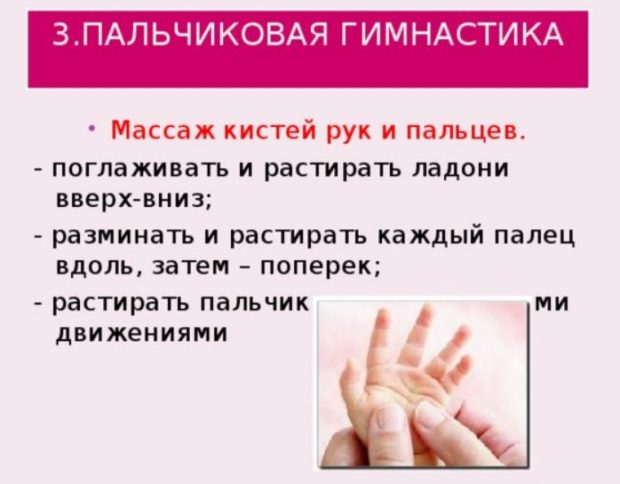
The difficulty of the exercises should increase gradually.
If you follow these simple rules, you and your child will achieve the desired results.
From 2 – 3 years: creative activities for fine motor skills
- Drawing with finger paints, brushes, crayons, pencils, felt-tip pens. You should start with finger paints: they are not toxic to children and do not require very developed movements of the fingers and palms. The next stage can be crayons (including wax), felt-tip pens (they do not require force when pressed) and only then pencils, when the baby learns to control the force of pressing.
- Games with paper. At first, it will be difficult for the baby to even just tear paper, but the baby progresses most quickly in the skills of destruction. So the next paper game will be cutting with scissors. Children usually master this skill between 3 and 4 years of age. Of course, these should be lightweight and ergonomic children's scissors, with short blades and comfortable rubberized finger rings. You can make an applique for your grandmother for her birthday: such a worthy occasion will give the baby strength and his activities meaning. Origami is the most difficult version of playing with paper; children begin to master this skill at the age of 4–6 years.
- Finger Theater. We develop dexterity, the ability to control our movements, and concentrate attention on one type of activity. We develop speech. And most importantly, we play and communicate!
More advanced motor skills activities
- Matches, counting sticks. We collect it, put it in a box, a glass, and build a house out of sticks. A more complicated version: the child collects matches using the same fingers of different hands (two index fingers, two middle fingers, etc.).
- Puzzles and mosaics. The most advanced games-activities for the development of hand-eye coordination, fine motor skills, spatial thinking and speech. At first they can be very large, with a small number of details (you can offer to play with a one-year-old baby). As you grow older, the size of the elements decreases, and their number increases.
The key to success in activities to develop fine motor skills in children is persistence and regularity. It’s good when your baby has the opportunity to practice hand and finger movements every day. If you notice that your child is not doing some movements very well (and at his age they could already), try to come up with as many games and activities as possible to practice this particular movement until it becomes easy, fast and clear.
As you can see, a significant part of the activities listed above are quite simple to organize, they do not require large material or time expenditures on the part of an adult, and they bring not only joy to the child, but also undoubted benefits.
How does hand massage affect a child’s body?
Massage techniques have a positive effect on the child’s health, because... each finger is related to a specific organ. The thumb is connected to the brain, the index finger is connected to the gastrointestinal tract, massaging the middle finger affects the spinal column, the ring finger is related to liver function, and the little finger is responsible for heart health.
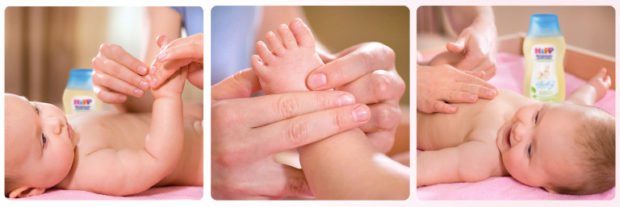
In order to help a child master speech skills, it is necessary to massage the hands and forearms, palms and fingers, elbows and shoulders. When doing exercises to develop motor skills, you need to constantly pronounce each movement, try to demonstrate them more often, select poems for gymnastics and turn the exercises into a game. This will make it more interesting and easier for the child to remember the movements, and the baby’s intelligence will increase.
As your child grows up, you can teach him self-massage techniques to develop fine motor skills.
Benefits of finger massage
You can start doing such a massage from the first hours of a baby’s life, but after consulting a doctor. This way the child’s development will be more rapid. Finger massage helps improve the baby’s mood, has a relaxing effect and has a positive effect on the entire body. Regular and proper massage will give the following benefits:
- The immune system becomes stronger;
- Blood pressure decreases;
- The functioning of the gastrointestinal tract is improved;
- The respiratory function of the body is normalized;
- The work of internal organs is stimulated;
- Increased concentration;
- The condition of the skin improves, the process of eliminating dead cells occurs;
- Speech development is stimulated;
- Relationships with parents become stronger.
Read also…. Types and techniques of children's therapeutic massage
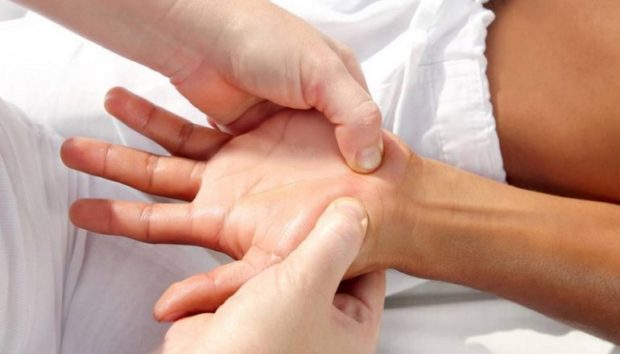
Before carrying out such a procedure, you should visit the office of a neurologist and speech therapist for the purpose of consultation. Experts will tell you whether the child needs finger massage or which technique is best to try.
Contraindications to hand massage
Although the impact on the child’s hands and fingers brings only a positive effect, there are times when you should refrain from massage. The procedure should not be carried out if:
- there are minor lesions on the skin of the hands;
- allergic intolerance appears on the hands;
- fungal diseases are present;
- there are inflammations on the hands and fingers;
- increased body temperature;
- there is an infection in the body.
In such cases, treatment should be started immediately. After normalization of the child’s general condition, you can begin massage procedures.

